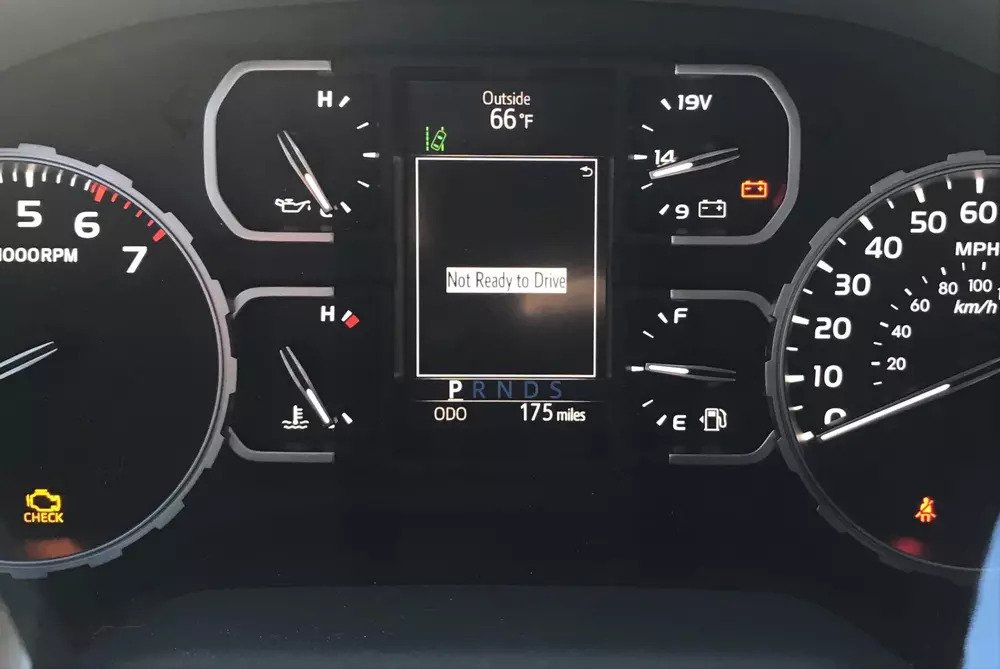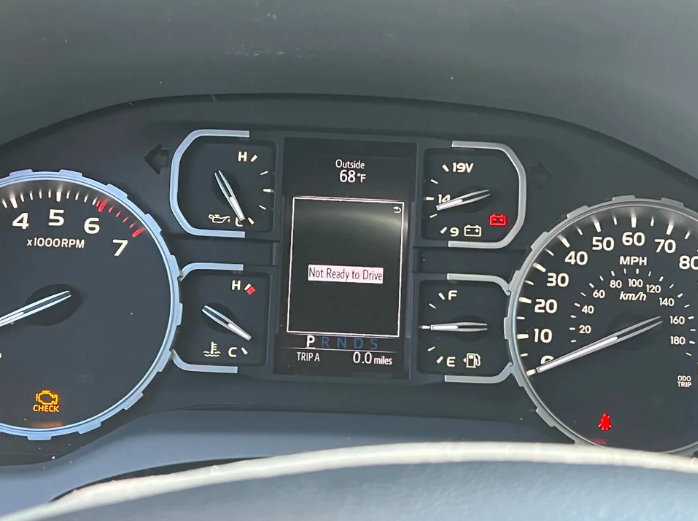When you receive the disconcerting Toyota “Not Ready to Drive” message, you should address the problem as soon as possible. So, how do you resolve the Toyota Not Ready to Drive message?
This message usually shows up when some of the car’s systems aren’t finished with their diagnostics or self-checks. The car becomes temporarily unusable as a result of it. The first step in fixing this is to make sure that every door is firmly shut because open doors can affect the readiness status. Furthermore, look for any warning lights on the dashboard and take care of any problems there as they might be a contributing factor to the readiness issue. It is advisable to refer to the owner’s manual of the car for detailed instructions on how to reset the readiness status if the message continues.
We will assist you in determining the causes of this problem in this article. You can use our guide to determine the best solution right away.

What Are Reasons For Toyota Not Ready To Drive Message?
Now we will discover the potential reasons for this message for effective troubleshooting:
Battery Disconnection
The OBD-II system may require driving cycles to complete readiness monitors if the vehicle’s ECU has recently been reset by a battery replacement or disconnect.
ECU Reset
The “Not Ready to Drive” message may also appear until the system has finished its self-checks, which can be caused by manually resetting the Engine Control Unit (ECU) or clearing trouble codes.
Incomplete Drive Cycles
In order to finish readiness monitors, the OBD-II system needs certain driving circumstances. It’s frequently necessary to drive both on highways and in cities. The system might not be ready if these prerequisites aren’t met.
Outstanding Fault Codes
You can look for unresolved problems in the car, like pending error codes or problems with the emissions control system. It might make it more difficult to finish readiness monitors.
Faulty Sensors
Sensor malfunctions, such as those pertaining to the mass airflow sensor or the oxygen (O2) sensor, could be additional causes. They may prevent readiness monitors from being completed.
Fuel Level Requirements
Certain vehicles have fuel requirements that must be met in order for certain readiness monitors to function. Making sure there is enough fuel may be required.
How To Fix Toyota Not Ready To Drive Message?

To address potential underlying issues, you can follow detailed guide:
Comprehensive Dashboard Inspection
Look over the dashboard carefully to see if there are any warning lights. It is imperative to address the issues indicated by each warning light prior to attempting to reset the readiness status.
Secure Door Closure
Verify that every door, including the trunk and hood, is shut firmly. It is crucial to make sure all doors are closed properly because if any are left open, the OBD-II system might not detect readiness.
Battery Connection Status
Resetting the OBD-II system may take some time if the car’s battery has recently been disconnected or replaced. You can proceed on city and highway driving so that the system can finish monitoring for readiness.
Follow Recommended Drive Cycles
If you’re looking for suggested drive cycles, check the owner’s manual. The OBD-II system can’t finish its readiness monitors until these particular driving circumstances are met. Over a predetermined distance, a drive cycle typically consists of a mix of city and highway driving.
Address Fault Codes Promptly
To find and remove any lingering error codes, use an OBD-II scanner. Fix the underlying problems that are generating trouble codes because they may hinder the readiness monitors from finishing their cycles.
Check Sensor Health
Assess the state of vital sensors, including mass airflow and oxygen (O2) sensors. Completing readiness monitors can be hindered by malfunctioning sensors. It is crucial to replace them if needed.
Verify Fuel Level
Certain readiness monitors might need to reach a particular fuel level in order to function. Make sure there is enough fuel in the car to fulfill these demands.
Refer to the Owner’s Manual
The owner’s manual for the car offers detailed instructions on how to resolve the “Not Ready to Drive” message. It is recommended that you adhere to the instructions provided in the handbook specific to your Toyota vehicle.
Look for Expert Guidance
Should the problem continue, you can get expert help from a certified Toyota service center. To find and fix any complicated problems affecting the OBD-II system, technicians can carry out a thorough diagnostic evaluation.
By doing so, you can ensure that your Toyota is ready for safe and optimal operation on the road.
Read More: How To Loosen The Stripped Bolt On Brake Caliper?
Should I Drive My Toyota When A Not Ready To Drive Message Appears?
When the “Not Ready to Drive” message appears in your Toyota, please check this before making a decision:
Safety First
It is generally not recommended to drive the car if the message refers to an unresolved issue or fault. The priority should always be safety.
Evaluate the Situation
Learn the significance of the message. You can drive if the problem is minor (battery replacement or completion of readiness monitors reset).
Check for Warning Lights
Make sure no additional warning lights are flashing, indicating serious problems. You should not drive your car if they appear.
Follow Manufacturer Guidelines
The owner’s manual for the car can provide you with detailed instructions on how to handle the “Not Ready to Drive” message. There may be instructions on this matter in certain manuals.
Drive with Caution
Drive carefully if you decide to operate the car while the “Not Ready to Drive” notice is on. You should avoid long journeys until the readiness monitors complete their cycles.
To sum up, when this message appears, you can drive your Toyota. Prioritize safety and consider consulting the owner’s manual or seek professional help to ensure the vehicle’s safe operation. If there are concerns about the safety or ability to operate the vehicle, you shouldn’t drive until the problem is fixed.
Read more: Why My Toyota Voice Recognition Not Available? (Solved)
